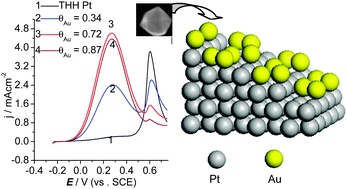Enhancing the activity and tuning the mechanism of formic acid oxidation at tetrahexahedral Pt nanocrystals by Au decoration†
Abstract
Tetrahexahedral Pt

* Corresponding authors
a
State Key Lab of Physical Chemistry of Solid Surfaces, Department of Chemistry, College of Chemistry and Chemical Engineering, Xiamen University, Xiamen 361005, China
E-mail:
tnsd@xmu.edu.cn, sgsun@xmu.edu.cn
Fax: +86 592 2183047
Tel: +86 592 2180181
b
Centre for the Theory and Application of Catalysis (CenTACat), School of Chemistry and Chemical Engineering, Queen's University Belfast, Belfast BT9 5AG, UK
E-mail:
w.lin@qub.ac.uk
Fax: +44 (0)28 9097 6524
Tel: +44 (0)28 9097 4175
Tetrahexahedral Pt

 Please wait while we load your content...
Something went wrong. Try again?
Please wait while we load your content...
Something went wrong. Try again?
H. Liu, N. Tian, M. P. Brandon, J. Pei, Z. Huangfu, C. Zhan, Z. Zhou, C. Hardacre, W. Lin and S. Sun, Phys. Chem. Chem. Phys., 2012, 14, 16415 DOI: 10.1039/C2CP42930F
To request permission to reproduce material from this article, please go to the Copyright Clearance Center request page.
If you are an author contributing to an RSC publication, you do not need to request permission provided correct acknowledgement is given.
If you are the author of this article, you do not need to request permission to reproduce figures and diagrams provided correct acknowledgement is given. If you want to reproduce the whole article in a third-party publication (excluding your thesis/dissertation for which permission is not required) please go to the Copyright Clearance Center request page.
Read more about how to correctly acknowledge RSC content.
 Fetching data from CrossRef.
Fetching data from CrossRef.
This may take some time to load.
Loading related content
